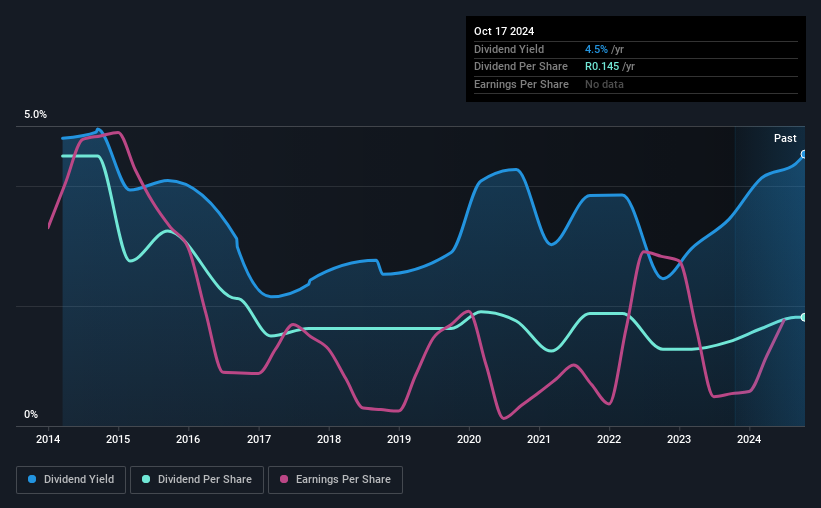There's A Lot To Like About Putprop's (JSE:PPR) Upcoming R00.085 Dividend
Putprop Limited (JSE:PPR) stock is about to trade ex-dividend in 4 days. The ex-dividend date is one business day before the record date, which is the cut-off date for shareholders to be present on the company's books to be eligible for a dividend payment. It is important to be aware of the ex-dividend date because any trade on the stock needs to have been settled on or before the record date. In other words, investors can purchase Putprop's shares before the 23rd of October in order to be eligible for the dividend, which will be paid on the 28th of October.
The company's next dividend payment will be R00.085 per share, and in the last 12 months, the company paid a total of R0.14 per share. Based on the last year's worth of payments, Putprop has a trailing yield of 4.5% on the current stock price of R03.20. If you buy this business for its dividend, you should have an idea of whether Putprop's dividend is reliable and sustainable. So we need to check whether the dividend payments are covered, and if earnings are growing.
View our latest analysis for Putprop
Dividends are typically paid out of company income, so if a company pays out more than it earned, its dividend is usually at a higher risk of being cut. Putprop is paying out just 16% of its profit after tax, which is comfortably low and leaves plenty of breathing room in the case of adverse events. Yet cash flow is typically more important than profit for assessing dividend sustainability, so we should always check if the company generated enough cash to afford its dividend. It paid out 12% of its free cash flow as dividends last year, which is conservatively low.
It's encouraging to see that the dividend is covered by both profit and cash flow. This generally suggests the dividend is sustainable, as long as earnings don't drop precipitously.
Click here to see how much of its profit Putprop paid out over the last 12 months.

Have Earnings And Dividends Been Growing?
Companies with consistently growing earnings per share generally make the best dividend stocks, as they usually find it easier to grow dividends per share. If earnings fall far enough, the company could be forced to cut its dividend. This is why it's a relief to see Putprop earnings per share are up 3.8% per annum over the last five years. Putprop is retaining more than three-quarters of its earnings and has a history of generating some growth in earnings. We think this is a reasonable combination.
Another key way to measure a company's dividend prospects is by measuring its historical rate of dividend growth. Putprop's dividend payments per share have declined at 8.7% per year on average over the past 10 years, which is uninspiring. It's unusual to see earnings per share increasing at the same time as dividends per share have been in decline. We'd hope it's because the company is reinvesting heavily in its business, but it could also suggest business is lumpy.
Final Takeaway
From a dividend perspective, should investors buy or avoid Putprop? Earnings per share growth has been growing somewhat, and Putprop is paying out less than half its earnings and cash flow as dividends. This is interesting for a few reasons, as it suggests management may be reinvesting heavily in the business, but it also provides room to increase the dividend in time. We would prefer to see earnings growing faster, but the best dividend stocks over the long term typically combine significant earnings per share growth with a low payout ratio, and Putprop is halfway there. There's a lot to like about Putprop, and we would prioritise taking a closer look at it.
So while Putprop looks good from a dividend perspective, it's always worthwhile being up to date with the risks involved in this stock. For example, we've found 4 warning signs for Putprop (2 are concerning!) that deserve your attention before investing in the shares.
Generally, we wouldn't recommend just buying the first dividend stock you see. Here's a curated list of interesting stocks that are strong dividend payers.
Have feedback on this article? Concerned about the content? Get in touch with us directly. Alternatively, email editorial-team (at) simplywallst.com.
This article by Simply Wall St is general in nature. We provide commentary based on historical data and analyst forecasts only using an unbiased methodology and our articles are not intended to be financial advice. It does not constitute a recommendation to buy or sell any stock, and does not take account of your objectives, or your financial situation. We aim to bring you long-term focused analysis driven by fundamental data. Note that our analysis may not factor in the latest price-sensitive company announcements or qualitative material. Simply Wall St has no position in any stocks mentioned.
 Index Options
Index Options CME Group
CME Group Nasdaq
Nasdaq Cboe
Cboe TradingView
TradingView Wall Street Journal
Wall Street Journal